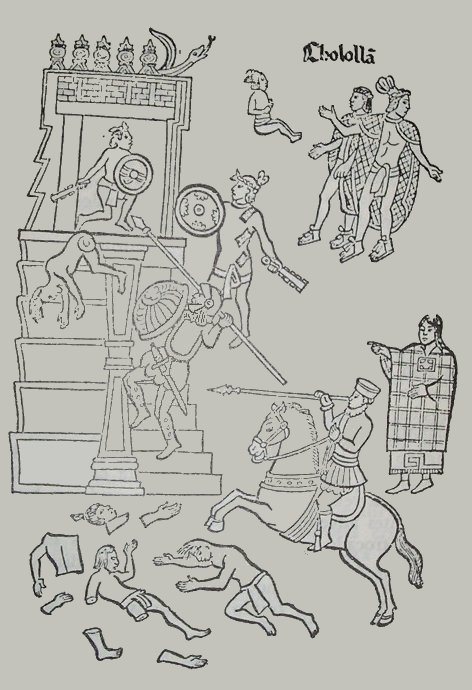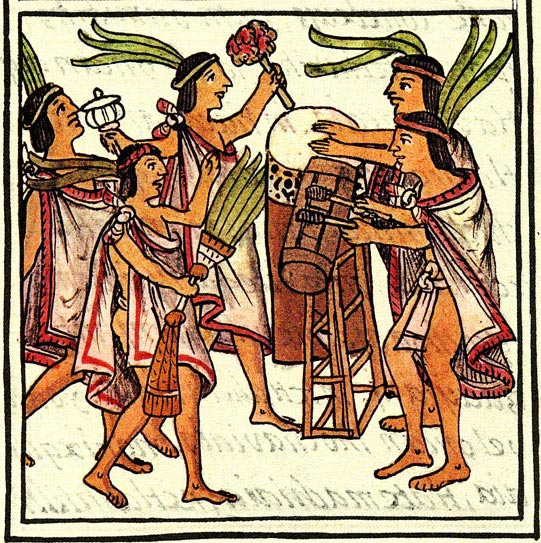Browse By Unit
2.4 Visión de los vencidos: "Se ha perdido el pueblo mexica" – Miguel León-Portilla
6 min read•june 18, 2024
Alejandra Ramos
Alejandra Ramos
Miguel León-Portilla's Visión de los vencidos: 'Se ha perdido el pueblo mexica'" is a collection of native stories that offer a distinctive viewpoint on the Spanish conquest of Mexico.

"La matanza de Cholula," Anonymous (1552). Courtesy of Wikimedia.
Context Behind Visión de los vencidos
Author Background
Mexican anthropologist, historian, and academic Miguel León-Portilla (1926–2019) specialized in Mesoamerican studies. His entire professional life was devoted to studying and advancing knowledge of indigenous cultures in Mexico, especially those of the Nahuatl-speaking cultures. The work of León-Portilla, especially Visión de los vencidos, made a significant contribution to the reinterpretation of indigenous history and the acknowledgment of their voices and viewpoints.

Image Courtesy of Daily Nous
Time and Place
📜Historical: Visión de los vencidos takes place in the 16th century, notably around the time when Mexico was conquered by the Spanish. It provides eyewitness descriptions of the contacts, battles, and subsequent repercussions on the indigenous peoples in order to offer the indigenous perspective on the events surrounding the fall of the Aztec Empire and the advent of the Spanish conquistadors.
🗺️Geographic: The geographic setting of the Aztec Empire, which was based in the Valley of Mexico, is the primary subject of the literary work. Tenochtitlan, the Aztec Empire's capital, as well as the surrounding areas and their scenery, which include lakes, mountains, and woods, are all explored in Visión de los vencidos stories.
Societal Context
👑Political: The political setting of Visión de los vencidos is centered on the power relationships between the native populations and the Spanish conquistadors. The narratives stress the opposition, alliances, and negotiations that took place throughout the conquest as they represent the battle for dominance and the collision of political systems.
🧑🏽🤝🧑🏻Socio-economic: The literature piece's socioeconomic setting depicts how the Spanish invasion affected indigenous civilizations. The narratives go into depth about how the Spanish colonizers exploited and oppressed the indigenous tribes, as well as how their social and economic systems were disrupted. Insights into the socioeconomic effects of the conquest, such as the loss of lands, resources, and autonomy, are given through the narratives.
🎭Cultural: Visión de los vencidos explores the cultural background of Mexico's indigenous populations, particularly those who speak Nahuatl. The narratives delve deeper into their cultural practices by examining their religious convictions, customs, and traditions. The literary work also explores the cultural confrontation between the Spanish and the indigenous peoples, stressing the significant influence of European colonization on indigenous culture.
Need to Know About "Se ha perdido el pueblo mexica"
Characters
- Aztec Nobles: Members of the Aztec nobility who held positions of influence inside the empire.
- Aztec Warriors: Native American warriors known as Aztecs fought the Spanish conquistadors to protect their lands and way of life during the conquest.
- Commoners: Native Americans from various socioeconomic origins who were affected by the Spanish invasion and the collapse of the Aztec Empire.
- Indigenous Leaders: Native American leaders who were influential in their communities, providing direction, making choices, and dealing with the Spanish conquistadors.
- Spanish Conquistadors: The advancing Spanish armies under the command of individuals like Hernán Cortés who aimed to subjugate and dominate the Aztec Empire.
Literary Terms and Devices
Narrador testigo (Witness Narrator)
In the story "Se ha perdido el pueblo mexica," a witness narrator describes the occasions leading up to the Spanish invasion of Mexico. The narrator describes the experiences, feelings, and viewpoints of the indigenous people throughout this turbulent time as an observer.
Narratorio
Due to the way that "Se ha perdido el pueblo mexica" combines literary storytelling with parts of historical narration, it can be categorized as a narratorio. The author, Miguel León-Portilla, has carefully chosen and assembled indigenous testimony and narratives to produce a coherent story that presents a communal viewpoint on the conquest.
Enumeración (Enumeration) The text uses the literary device of enumeration to give a thorough account of the events leading up to and following the Spanish invasion. It provides a thorough representation of the indigenous way of life and the effects of the invasion by listing a variety of elements, including occasions, rituals, cultural practices, and social structures.
Polisíndeton
The repetition of conjunctions in "Se ha perdido el pueblo mexica" uses polysyndeton to emphasize the combined influence of different parts. This technique gives the story a rhythm and intensity that highlights the feelings, challenges, and suffering experienced by the native people during the conquest.
Asíndeton
Asíndeton is employed in the text through the deliberate omission of conjunctions, creating a fragmented and concise narrative style. This technique is used to convey a sense of urgency, emphasize key points, and quicken the pace of the storytelling. It reflects the turmoil, chaos, and disruption experienced by the indigenous people due to the Spanish conquest.
Summary of "Se ha perdido el pueblo mexica"
Miguel León-Portilla's "Se ha perdido el pueblo mexica" is a powerful and moving collection of native stories that offers a synthesis of viewpoints on the Spanish invasion of Mexico and the collapse of the Aztec Empire. León-Portilla reveals the conquest's enormous effects on the indigenous peoples, their way of life, and their sense of cultural identity through their own voices and narratives. In order to highlight the vanquished people's fortitude, resistance, and the lasting impact of their civilization, the book depicts the destruction, loss, and agony they endured. The voices of people who saw and experienced the drastic transformation of their environment at the hands of the Spanish colonists are amplified in this important historical and literary work.

Extract from the Florentine Codex, Anonymous (16th Century). Courtesy of Wikimedia.
Themes in "Se ha perdido el pueblo mexica"
Sociedades en contacto (Societies in Contact)
The dynamics of communities in touch during the Spanish conquest of Mexico are examined in "Se ha perdido el pueblo mexica". The text explores how the Mexica (Aztec) culture and the Spanish conquistadors' imperialistic advance clashed with indigenous Mesoamerican civilization. It looks at the power struggles, cultural clashes, and significant repercussions that came about as a result of the interaction between these two very dissimilar societies.
El imperialismo (Imperialism)
The issue of imperialism is a major one in "Se ha perdido el pueblo mexico." The work explores the Spanish conquistadors' imperialistic aspirations and their pursuit of dominance over indigenous peoples through power, wealth, and influence. As indigenous societies were conquered, their lands were taken, and their cultural traditions were prohibited in the name of colonization, it emphasizes the exploitative and oppressive aspect of imperialism.
La trayectoria y la transformación (Trajectory and Transformation)
"Se ha perdido el pueblo mexica" traces the development and decline of the Mexica (Aztec) civilization from its peak as a vast empire to its eventual demise during the conquest by the Spanish. The text describes the tremendous and permanent changes that the indigenous peoples have gone through, including the loss of their sovereignty, the upheaval of social norms, the deterioration of cultural practices, and the extinction of their population. It examines the ongoing effects of this period of change and how they have affected the identity and heritage of the Mexican people.
Significance and Analysis
Miguel León-Portilla's "Se ha perdido el pueblo mexica" is very important historically and culturally. It examines the Spanish conquest from the viewpoint of the indigenous people and the interpretation of that exploration has had a significant influence on how we comprehend this historical era. "Se ha perdido el pueblo mexica" is significant because it amplifies indigenous perspectives and challenges conventional Eurocentric narratives. León-Portilla emphasizes the agency, resiliency, and humanity of the conquered indigenous communities by emphasizing their experiences and viewpoints. The collection of first-person experiences is a potent example of how people overcame great obstacles by remaining resilient.
The book also illuminates the negative effects of colonization, such as the destruction of cultural legacy, the upheaval of social norms, and the annihilation of populations as a result of conflict, disease, and forced labor. It highlights the damaging effects of imperialism and how they continue to affect the Mexican people's sense of identity and collective memory. In addition, "Se ha perdido el pueblo mexica" questions popular historical narratives that frequently exclude or marginalize indigenous voices. As a result, the conquest and its aftermath can be understood in a more complex and inclusive way, contributing to the larger movement of decolonizing history.
<< Hide Menu
2.4 Visión de los vencidos: "Se ha perdido el pueblo mexica" – Miguel León-Portilla
6 min read•june 18, 2024
Alejandra Ramos
Alejandra Ramos
Miguel León-Portilla's Visión de los vencidos: 'Se ha perdido el pueblo mexica'" is a collection of native stories that offer a distinctive viewpoint on the Spanish conquest of Mexico.

"La matanza de Cholula," Anonymous (1552). Courtesy of Wikimedia.
Context Behind Visión de los vencidos
Author Background
Mexican anthropologist, historian, and academic Miguel León-Portilla (1926–2019) specialized in Mesoamerican studies. His entire professional life was devoted to studying and advancing knowledge of indigenous cultures in Mexico, especially those of the Nahuatl-speaking cultures. The work of León-Portilla, especially Visión de los vencidos, made a significant contribution to the reinterpretation of indigenous history and the acknowledgment of their voices and viewpoints.

Image Courtesy of Daily Nous
Time and Place
📜Historical: Visión de los vencidos takes place in the 16th century, notably around the time when Mexico was conquered by the Spanish. It provides eyewitness descriptions of the contacts, battles, and subsequent repercussions on the indigenous peoples in order to offer the indigenous perspective on the events surrounding the fall of the Aztec Empire and the advent of the Spanish conquistadors.
🗺️Geographic: The geographic setting of the Aztec Empire, which was based in the Valley of Mexico, is the primary subject of the literary work. Tenochtitlan, the Aztec Empire's capital, as well as the surrounding areas and their scenery, which include lakes, mountains, and woods, are all explored in Visión de los vencidos stories.
Societal Context
👑Political: The political setting of Visión de los vencidos is centered on the power relationships between the native populations and the Spanish conquistadors. The narratives stress the opposition, alliances, and negotiations that took place throughout the conquest as they represent the battle for dominance and the collision of political systems.
🧑🏽🤝🧑🏻Socio-economic: The literature piece's socioeconomic setting depicts how the Spanish invasion affected indigenous civilizations. The narratives go into depth about how the Spanish colonizers exploited and oppressed the indigenous tribes, as well as how their social and economic systems were disrupted. Insights into the socioeconomic effects of the conquest, such as the loss of lands, resources, and autonomy, are given through the narratives.
🎭Cultural: Visión de los vencidos explores the cultural background of Mexico's indigenous populations, particularly those who speak Nahuatl. The narratives delve deeper into their cultural practices by examining their religious convictions, customs, and traditions. The literary work also explores the cultural confrontation between the Spanish and the indigenous peoples, stressing the significant influence of European colonization on indigenous culture.
Need to Know About "Se ha perdido el pueblo mexica"
Characters
- Aztec Nobles: Members of the Aztec nobility who held positions of influence inside the empire.
- Aztec Warriors: Native American warriors known as Aztecs fought the Spanish conquistadors to protect their lands and way of life during the conquest.
- Commoners: Native Americans from various socioeconomic origins who were affected by the Spanish invasion and the collapse of the Aztec Empire.
- Indigenous Leaders: Native American leaders who were influential in their communities, providing direction, making choices, and dealing with the Spanish conquistadors.
- Spanish Conquistadors: The advancing Spanish armies under the command of individuals like Hernán Cortés who aimed to subjugate and dominate the Aztec Empire.
Literary Terms and Devices
Narrador testigo (Witness Narrator)
In the story "Se ha perdido el pueblo mexica," a witness narrator describes the occasions leading up to the Spanish invasion of Mexico. The narrator describes the experiences, feelings, and viewpoints of the indigenous people throughout this turbulent time as an observer.
Narratorio
Due to the way that "Se ha perdido el pueblo mexica" combines literary storytelling with parts of historical narration, it can be categorized as a narratorio. The author, Miguel León-Portilla, has carefully chosen and assembled indigenous testimony and narratives to produce a coherent story that presents a communal viewpoint on the conquest.
Enumeración (Enumeration) The text uses the literary device of enumeration to give a thorough account of the events leading up to and following the Spanish invasion. It provides a thorough representation of the indigenous way of life and the effects of the invasion by listing a variety of elements, including occasions, rituals, cultural practices, and social structures.
Polisíndeton
The repetition of conjunctions in "Se ha perdido el pueblo mexica" uses polysyndeton to emphasize the combined influence of different parts. This technique gives the story a rhythm and intensity that highlights the feelings, challenges, and suffering experienced by the native people during the conquest.
Asíndeton
Asíndeton is employed in the text through the deliberate omission of conjunctions, creating a fragmented and concise narrative style. This technique is used to convey a sense of urgency, emphasize key points, and quicken the pace of the storytelling. It reflects the turmoil, chaos, and disruption experienced by the indigenous people due to the Spanish conquest.
Summary of "Se ha perdido el pueblo mexica"
Miguel León-Portilla's "Se ha perdido el pueblo mexica" is a powerful and moving collection of native stories that offers a synthesis of viewpoints on the Spanish invasion of Mexico and the collapse of the Aztec Empire. León-Portilla reveals the conquest's enormous effects on the indigenous peoples, their way of life, and their sense of cultural identity through their own voices and narratives. In order to highlight the vanquished people's fortitude, resistance, and the lasting impact of their civilization, the book depicts the destruction, loss, and agony they endured. The voices of people who saw and experienced the drastic transformation of their environment at the hands of the Spanish colonists are amplified in this important historical and literary work.

Extract from the Florentine Codex, Anonymous (16th Century). Courtesy of Wikimedia.
Themes in "Se ha perdido el pueblo mexica"
Sociedades en contacto (Societies in Contact)
The dynamics of communities in touch during the Spanish conquest of Mexico are examined in "Se ha perdido el pueblo mexica". The text explores how the Mexica (Aztec) culture and the Spanish conquistadors' imperialistic advance clashed with indigenous Mesoamerican civilization. It looks at the power struggles, cultural clashes, and significant repercussions that came about as a result of the interaction between these two very dissimilar societies.
El imperialismo (Imperialism)
The issue of imperialism is a major one in "Se ha perdido el pueblo mexico." The work explores the Spanish conquistadors' imperialistic aspirations and their pursuit of dominance over indigenous peoples through power, wealth, and influence. As indigenous societies were conquered, their lands were taken, and their cultural traditions were prohibited in the name of colonization, it emphasizes the exploitative and oppressive aspect of imperialism.
La trayectoria y la transformación (Trajectory and Transformation)
"Se ha perdido el pueblo mexica" traces the development and decline of the Mexica (Aztec) civilization from its peak as a vast empire to its eventual demise during the conquest by the Spanish. The text describes the tremendous and permanent changes that the indigenous peoples have gone through, including the loss of their sovereignty, the upheaval of social norms, the deterioration of cultural practices, and the extinction of their population. It examines the ongoing effects of this period of change and how they have affected the identity and heritage of the Mexican people.
Significance and Analysis
Miguel León-Portilla's "Se ha perdido el pueblo mexica" is very important historically and culturally. It examines the Spanish conquest from the viewpoint of the indigenous people and the interpretation of that exploration has had a significant influence on how we comprehend this historical era. "Se ha perdido el pueblo mexica" is significant because it amplifies indigenous perspectives and challenges conventional Eurocentric narratives. León-Portilla emphasizes the agency, resiliency, and humanity of the conquered indigenous communities by emphasizing their experiences and viewpoints. The collection of first-person experiences is a potent example of how people overcame great obstacles by remaining resilient.
The book also illuminates the negative effects of colonization, such as the destruction of cultural legacy, the upheaval of social norms, and the annihilation of populations as a result of conflict, disease, and forced labor. It highlights the damaging effects of imperialism and how they continue to affect the Mexican people's sense of identity and collective memory. In addition, "Se ha perdido el pueblo mexica" questions popular historical narratives that frequently exclude or marginalize indigenous voices. As a result, the conquest and its aftermath can be understood in a more complex and inclusive way, contributing to the larger movement of decolonizing history.

© 2025 Fiveable Inc. All rights reserved.